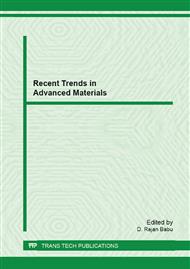p.319
p.324
p.329
p.334
p.341
p.345
p.350
p.357
p.361
A Polyol Route LiFePO4 Cathode Material for Li-Batteries
Abstract:
Lithium ion battery technology has played a key role in portable electronics revolution, and it is vigorously pursued for electric vehicle applications. LiFePO4 has recently received a great deal of attention due to its potential usage as a next-generation cathode material for lithium-ion batteries such as power tools, electric vehicles (EVs)and hybrid electric vehicles (HEVs),etc.LiFePO4 is advantageous when comparing other conventional cathode materials such as LiCoO2, LiNiO2 and LiMn2O4, namely, it is inexpensive, environmentally benign and thermally stable, etc.. In the present work, LiFePO4 has been prepared using polyol method and its crystal structure has been confirmed by powder X-ray diffraction. The as-prepared LiFePO4 has olivine structure with space group Pnma and orthorhombic lattice parameters are calculated as a=10.3999Å, b=6.0070Å and c=4.6388Å. The functional group vibrations have been analyzed using Fourier Transform Infrared Spectroscopy (FT-IR). The surface morphology of synthesized material have been studied by scanning electron microscopy (SEM) and the compositional analysis were also been carried out through EDX analysis.
Info:
Periodical:
Pages:
341-344
Citation:
Online since:
October 2012
Price:
Сopyright:
© 2012 Trans Tech Publications Ltd. All Rights Reserved
Share:
Citation:


